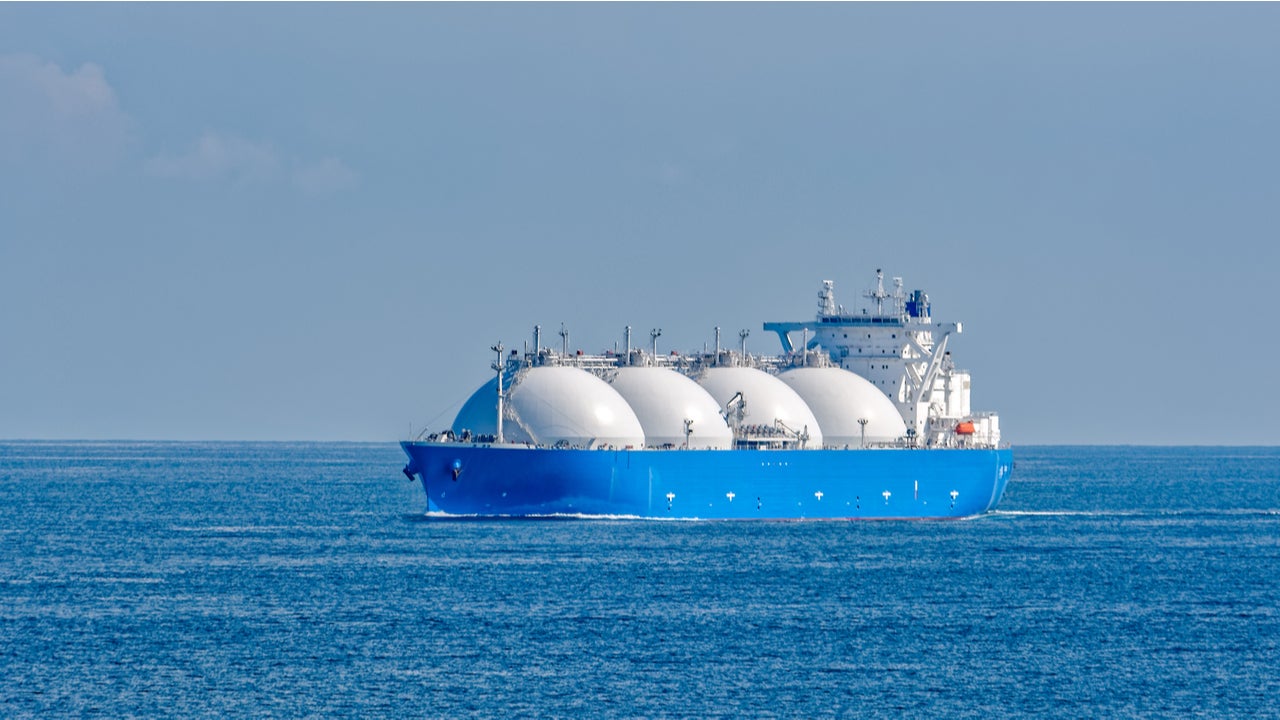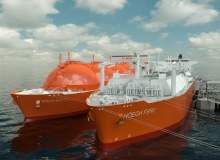
The top trends are the most mentioned terms or concepts among Twitter discussions of more than 150 LNG experts tracked by GlobalData’s Oil and Gas Influencer platform during the third quarter (Q3) of 2021.
1. Tankers – 513 mentions
Ship designing company Deltamarin and French LNG containment expert GTT receiving the approval for a new LNG-powered Aframax tanker design, and GTT securing a design contract for two LNG carriers, were some of the popular discussions on tankers in Q3 2021.
Svetlana Modeva, editor at marine traffic analyser VesselFinder, shared an article on Deltamarin and GTT receiving American Bureau of Shipping (ABS) Approval in Principle (AiP) for a new LNG-powered Aframax tanker design. The approval was given at the Gastech 2021 exhibition held in Dubai. The article noted that the new tanker design is environment-friendly, reduces carbon emissions and offers enhanced autonomy. The clean-fuel tanker design was developed based on GTT’s membrane-type LNG tanks and using Deltamarin’s ship designing capabilities.
The term was also mentioned in a tweet by a website focused on the offshore sector, on GTT securing a contract from Korean shipbuilders Hyundai Samho Heavy Industries (HSHI) and Daewoo Shipbuilding and Marine Engineering (DSME) to design two new LNG carriers. The two ships will have a cargo capacity of 174,000m3. HSHI is building the LNG carrier for a Liberian ship owner, while DSME is building the carrier for an Asian ship owner, the article detailed. The LNG carriers are expected to be built and delivered by the end of 2023.
Deltamarin and GTT receive ABS Approval in Principle (AiP) for a new LNG-fueled Aframax vessel designhttps://t.co/9KUGL69nIx #Deltamarin #GTT #AmericanBureauofShipping #ABS #AiP #Aframax #tanker #ShipDesign
— Svetlana Modeva (@SvetlanaModeva) September 25, 2021
How well do you really know your competitors?
Access the most comprehensive Company Profiles on the market, powered by GlobalData. Save hours of research. Gain competitive edge.
 Company Profile – free sample
Company Profile – free sampleThank you!
Your download email will arrive shortly
Not ready to buy yet? Download a free sample
We are confident about the unique quality of our Company Profiles. However, we want you to make the most beneficial decision for your business, so we offer a free sample that you can download by submitting the below form
By GlobalData
2. Pricing – 274 mentions
Energy companies Petronas and China National Offshore Oil Corporation (CNOOC) signing an LNG supply agreement, demand and supply issues leading to surge in LNG prices, and Russian LNG producer Novatek doubling its profits after the recovery in oil and gas prices and output were some of the popular discussions in Q3.
Stephen Stapczynski, an Asia-focused LNG reporter, shared a press release on CNOOC entering an agreement with Malaysia’s oil and gas firm Petronas to supply 2.2 million tonnes (Mt) of LNG a year for the next ten years. Valued approximately $7bn, the deal will also include LNG supply from the LNG Canada facility, which is expected to begin production in the middle of the decade. The LNG prices under the agreement are partially indexed to Canada’s gas benchmark, Stapczynski added.
Another discussion on pricing was around reporter Clyde Russell’s tweet on the robust LNG demand from Asia and Europe fuelling the rally in spot LNG prices. The top exporters, including Qatar, Australia, Russia and the US, are shipping in smaller volumes leading to supply shortages although that trend may end soon, Russell added. The article highlighted that spot prices are usually much higher on an annual basis, but the rise in prices is mainly attributed to the drop in LNG demand in the middle of 2020 when parts of the global economies were locked down due to the coronavirus pandemic.
In another tweet, Susan Sakmar, a visiting assistant professor and energy law scholar at the University of Houston Law Center, shared an article on Novatek doubling its profit to $1.35bn in the second quarter of the year as oil and gas output and prices recovered. The company reported a 129% increase in its normalised earnings, including joint ventures (JVs), to $2.21bn, the article further detailed.
China Buys More LNG From Malaysia's Petronas
🇨🇳🤝🇲🇾Petronas will supply Cnooc with 2.2 million tons/year of LNG for 10 years
🇨🇦 That includes supply from the LNG Canada project, which will begin production in a few years. Prices are partially indexed to Canada's gas benchmark pic.twitter.com/CmHGIoBlPP
— Stephen Stapczynski (@SStapczynski) July 7, 2021
3. Exports – 124 mentions
Energy sector lenders becoming increasingly optimistic about the oil and gas sector as demand and exports surge, LNG exports from the US remaining flat during early August, and exports playing a major role in the Henry Hub gains were some of the discussions around LNG exports in the third quarter.
Susan Sakmar shared an article on energy lenders becoming increasingly optimistic about the energy sector due to a rebound in oil prices and a surge in natural gas demand in 2021. Demand was high especially from Asia and Europe leading to increase in LNG exports from the US. Bankers further predicted more drilling and a higher loan demand in the second half of 2021 adding that it would contribute to excess cash and credit for producers who could utilise the funds for new projects.
The term was also mentioned by a website focused on the offshore sector in a tweet about an article on LNG exports from the US between 05 August and 11 August 2021. The US Energy Information Administration (EIA) reported that US LNG exports remained flat week over week during that period. The article further noted that 21 vessels with a LNG capacity of 77 billion cubic feet left the US, while the Henry Hub spot price dropped to $4.07/MMBtu the same week.
In another tweet, LNG Global, an oil and energy business development company, discussed how exports have played a major role in contributing to the nine-day gains at Henry Hub, a distribution hub on the natural gas pipeline system in Erath, Louisiana. The article highlighted that the US dry gas production remained constant despite stronger commodity prices and was not able to offset the international demand for LNG. Analysts stated that low US storage capacities and strong cooling demand were contributing factors to the rise in prices adding that hot weather and low storage did not led to such gains in the past.
Bullish outlook for lenders in #energy sector. Demand for #natgas in US is soaring this summer amid hot weather & power gen needs. Demand in Asia & Europe is up & storage full, which is driving #USLNG & Mexican pipeline exports. #LNG #ONGT https://t.co/Wuya23NgY3 via @NGInews
— Susan Sakmar (@SusanSakmar) August 11, 2021
4. Imports – 60 mentions
China becoming a top LNG importer in 2021, Japanese gas company Saibu Gas importing its first LNG shipment from Novatek, and Japan’s 2030 power generating targets likely to lead to a drop in LNG and thermal coal imports were some of the discussions related to LNG imports in Q3.
Henning Gloystein, director of political risk research and consulting firm Eurasia Group, shared a chart that showed the rise in LNG imports to China. The country emerged as the top LNG importer in 2021, which led to an increase in LNG prices. The chart revealed that China’s monthly imports in July were 8.9 billion cubic metres (bcm) compared to Japan’s 8.8bcm and South Korea’s 5.4bcm. Gloystein added that another reason for the rise in prices was the decline in Russia’s pipeline exports through Ukraine in the European Union (EU).
The term was also discussed with reference to Japan’s Saibu Gas importing its first LNG shipment from Novatek, as mentioned in an article shared in a tweet by Stephen Stapczynski. Saibu Gas imported 70,000t of LNG, which will be temporarily stored at Kitakyushu City’s LNG terminal for overseas sale to buyers in Asia, the article noted. Saibu Gas and Novatek are also exploring the possibility of establishing a JV to supply LNG and natural gas to Asia, where the demand has increased.
In another tweet, Clyde Russell referred to Japan’s latest electricity plan, which could lead to a decline in LNG and coal imports, especially from Australia. Japan aims to increase renewable energy capacity to 36%-38% of the electricity mix by 2030, which is double the 18% attained in the fiscal year ending March 2020, the article detailed. The rise in renewable energy will lead to a drop in LNG and coal imports, with Australia slated to be the biggest loser. LNG usage for power generation will dip to 20% from about 37%, the article highlighted.
#China's surge past Japan as the top #LNG importer is partly why prices have spiked. Another reason is in Europe, where #Russia's pipeline exports via #Ukraine have declined, probably to make a case for #NordStream2, forcing the EU to turn to more LNG for now. pic.twitter.com/UBriKnQRA5
— Henning Gloystein (@hgloystein) August 31, 2021
5. Cargo – 56 mentions
The port of Corpus Christi handling record levels of cargo in the first half of 2021, energy company ENN purchasing 26 LNG cargoes for 2022-2023, and oil and gas company Shell delivering carbon-neutral LNG cargo to gas company Osaka Gas were some of the popular discussions that mentioned cargo in the third quarter.
Steve Everley, managing director at business advisory firm FTI Consulting, shared an article on the increase in port activity and cargo shipments at the port of Corpus Christi in the first six months of 2021. The uptick was a result of a 72% year-over-year increase in LNG exports, the article noted. The port handled approximately 80.5Mt of cargo in the first six months of 2021.
Christian Schmollinger, a commodities and energy editor, shared an article on ENN LNG agreeing to purchase 26 LNG cargoes for 2022 and 2023 through a tender for restocking the new storage facilities opened at its Zhoushan terminal. The cargoes were purchased at a premium from $1 to $2 per million British Thermal Unit over the Title Transfer Facility (TTF), a virtual trading centre for natural gas in The Netherlands, the article detailed.
A natural gas and LNG news website tweeted about in an article on Shell delivering a carbon-neutral LNG cargo to Osaka Gas. The cargo was delivered under a purchase agreement signed with energy company Brunei LNG. It is the first carbon-neutral LNG cargo for both Brunei LNG and Osaka Gas and was delivered to the Senboku LNG terminal in Japan. It will allow Osaka Gas to deliver carbon-neutral LNG to Japanese commercial and industrial consumers, the article detailed.
https://twitter.com/saeverley/status/1417864022951661574





